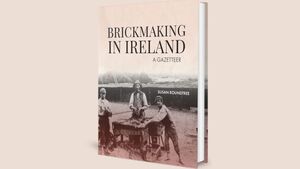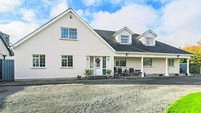How Athy’s brick industry came to an end

written by Susan Roundtree and published recently by Wordwell, is a comprehensive record of where clay bricks were made in Ireland and how this locally made indigenous material shaped the character of Irish buildings for more than four centuries. Maisie Candy, who with her pupils in Churchtown National School, produced a short-written account of brick making in the Churchtown locality, identified thirteen brickyards in the Churchtown area at the beginning of the 20th century. These were the Morrins of Ballyroe, Keegans of Ballyroe, Foleys of Brownstone, Doyles of Churchtown, Donlons of Shean, two on Heydens farm at Brownstone, Lawlers of Churchtown, Heydens of Churchtown, Hosies of Coursetown, Doyles, Maxwells and the Harris household of Malthouse.
George Wilkinson, architect, in the first year of the Great Famine wrote of how bricks of good quality were being made in the Athy area and sent by canal boat to Dublin. Athy’s handmade bricks are today to be found in the Dublin suburbs, particularly Rathmines and Rathgar and in Guinness’s malthouse and hop stores.
The earliest ordnance survey map of 1827 shows brickworks around Athy. These included three separate brickyards in Milltown and three brickyards in the adjoining townland of Cardington. George Kinahan, geologist, in his papers 1883-1889 refers to the first-class facing brick, 9 inches x 4 ½ inches x 3 inches made by Webster Company of Athy. This is a name I have never previously met with in connection with brickmaking in South Kildare.
The Geological Survey of Ireland database recorded the location of eight brickmaking factories in the Athy area. Courtown West, Blackford, Barrowford which was linked by tramway to the Athy Brickworks, three at Milltown and two at Cardington.
Perhaps the best-known brick factory was the Athy Brick and Tile factory which was opened at Barrowford on Thursday 8 June 1893. Bricks stamped ‘Athy Brick and Tile Co.’ were produced by machinery initially for building works on the Curragh Army Camp and subsequently for the Dublin market. The factory had its own railway line siding from about 1900 which allowed the bricks to be brought by train using the Dublin Waterford line.
The brickmaking industry faced severe competitive difficulties in the early decades of the 20th century. Concrete was increasingly used for building construction and bricks, more expensive to produce, were gradually confined to facing and decorative uses. The closure of the brickyards in South Kildare began as early as the 1890s, while Athy Brick & Tile Co, the last brickyard still operating, was experiencing difficulties in the 1920s, if not earlier.
It had fallen into decline following the start of World War I and its railway siding was removed in the last year of the war. Its machine-made brick was still in demand but Athy’s Urban District Council building programme in 1932 was the subject of a request by the council’s architect, Mr Heaney, that Dolphin Barn brick be used instead of Athy brick which he indicated was not available in sufficient numbers.
The council understandably directed that only Athy brick was to be used. Five years later councillor Tom Carbery failed to get his fellow councillors to support his motion not to use Athy bricks for any local housing schemes unless the brickyard proprietor P.P. O’Doyle paid union wages to his workers.
Peter P. Doyle, as secretary of Athy Tile & Brick company, had attempted to revive the brickmaking industry in south Kildare in the 1920s and was helped in this by the local council’s slum clearance programme which saw the construction of houses at Dooley’s Terrace and St Joseph’s Terrace.
However, this was to change in the mid-1930s. On 20 January 1936 at a meeting of Athy Urban District Council the members considered a letter received from P.P. Doyle of Woodstock Street who was then the managing director of the Athy Tile & Brick Co.
In that letter Mr Doyle referred to an architect’s report regarding dry rot in the floors of houses recently built at St Patrick’s Avenue. He pointed out that the boards laid in concrete was proof of the unsuitability of concrete for building purposes.
He went on to claim that the houses erected in brick at the Bleach over ten years previously had given every satisfaction. He continued: ‘We have supplied Athy bricks to the Christian Brothers, Messrs Guinness’s, the Great Southern Railway branch in Athy which is a classic in architecture.’ He quoted the architect William H. Byrne who used Athy brick in the Hibernian Bank, Athy and always found the quality bricks very satisfactory. Messrs Bradbury and Evans architects, also quoted by Doyle, claimed that ‘Athy bricks are harder and better burned than any other bricks used in Dublin and that their appearance in our opinion is vastly superior’.
Mr Doyle’s letter was read by the town clerk without any comment being made by the councillors who were present at the meeting. Clearly if the local brick factory could not get support from the town’s Urban District Councillors its future was dim. And so it was. Athy Tile & Brick Co., the last surviving brick factory in south Kildare, closed soon afterwards.
The brickmaking industry in South Kildare was for many men, women and young boys for decades in the 19th century and into the 20th century the only employment available in the area, apart from seasonal agricultural labouring. The brickmaking men and women and young boys who worked as bankers, middlers, sourers, upstrikers, off bearers, wheelers, catchers and burners are like their job titles long forgotten.






